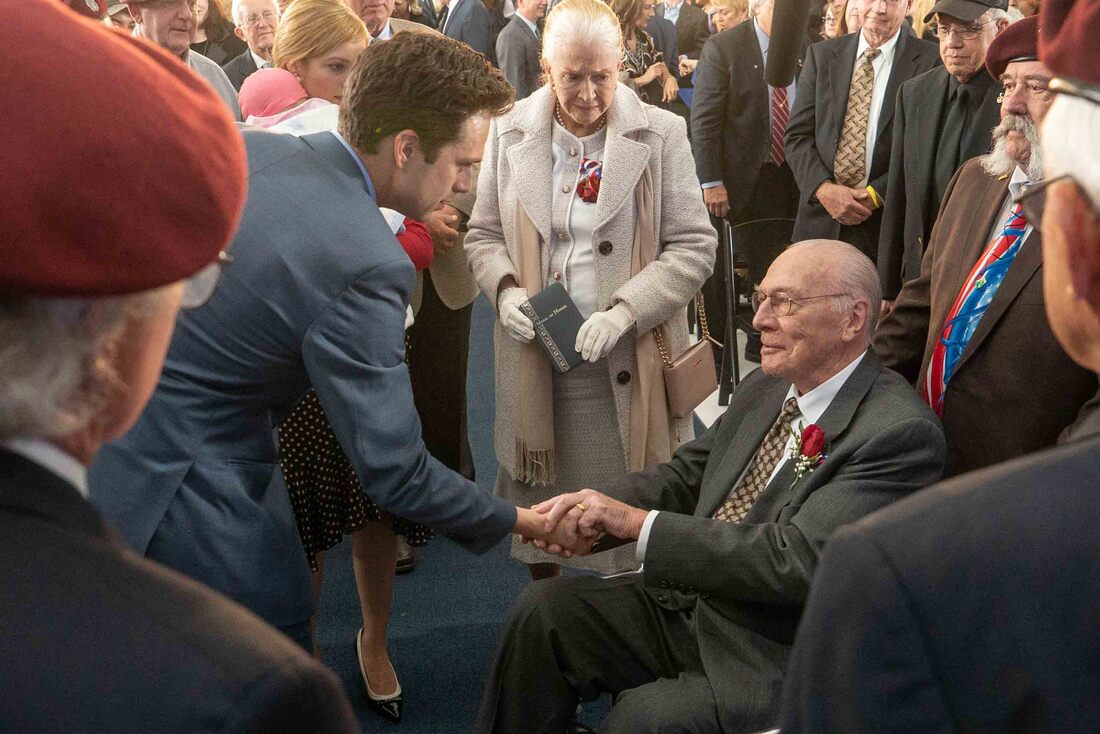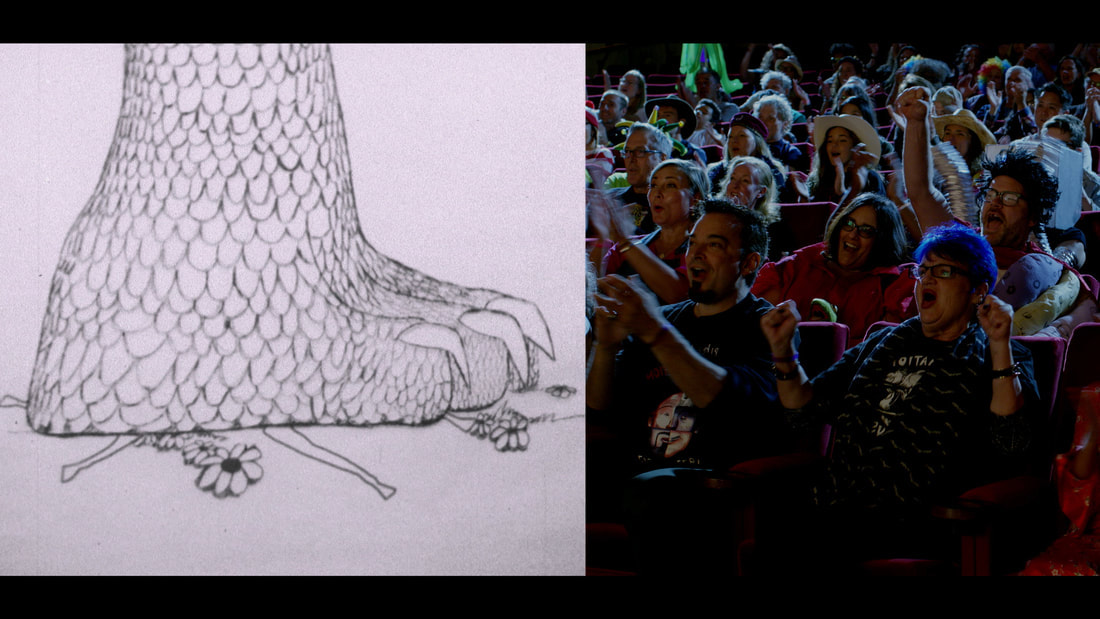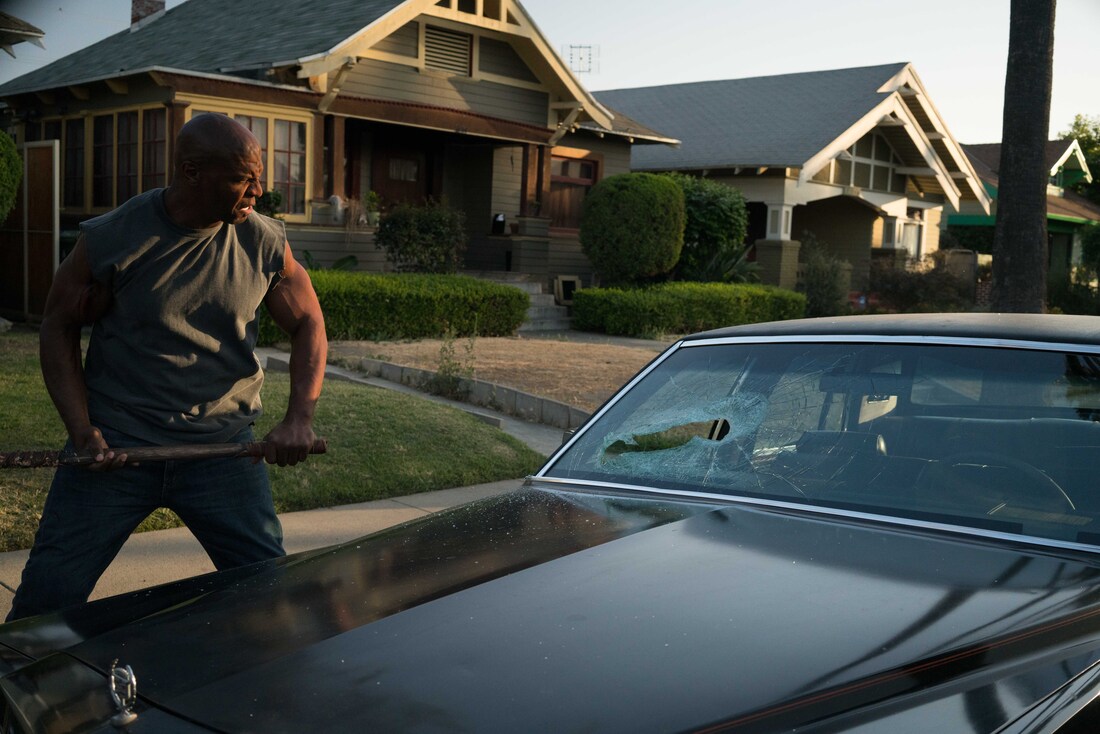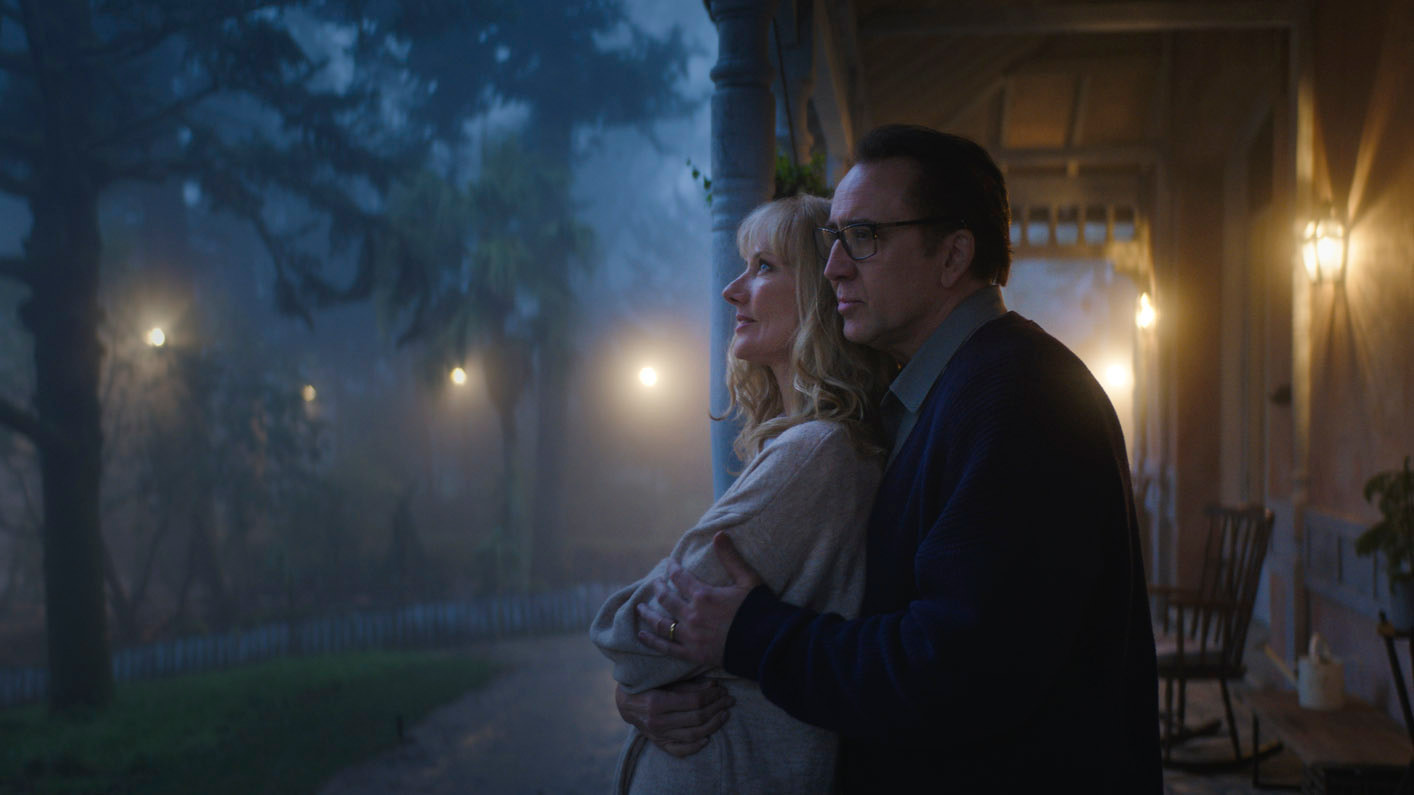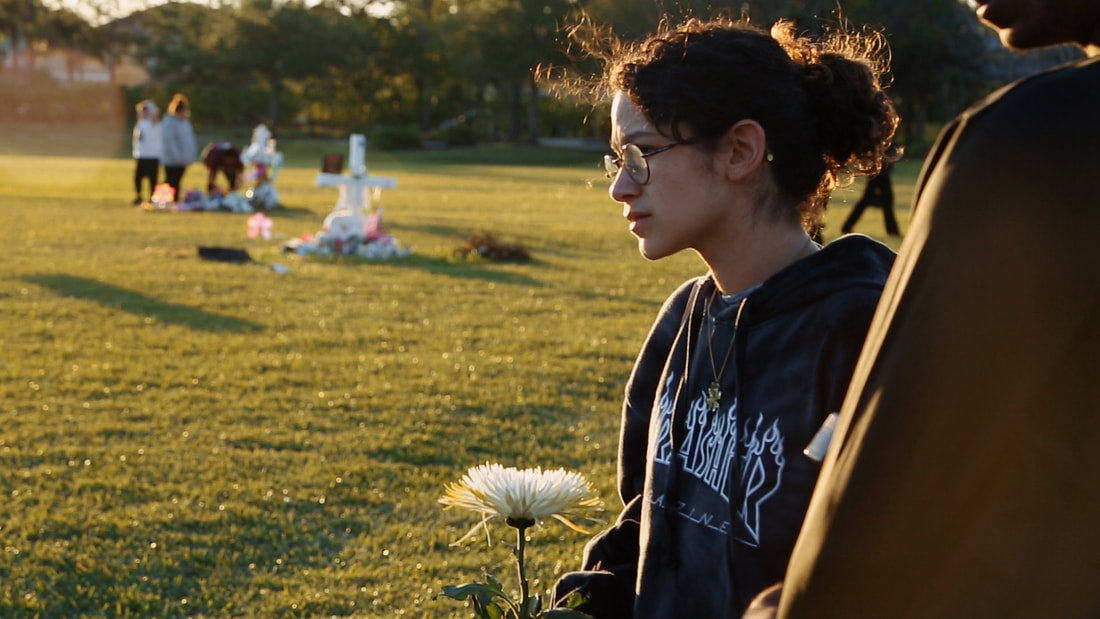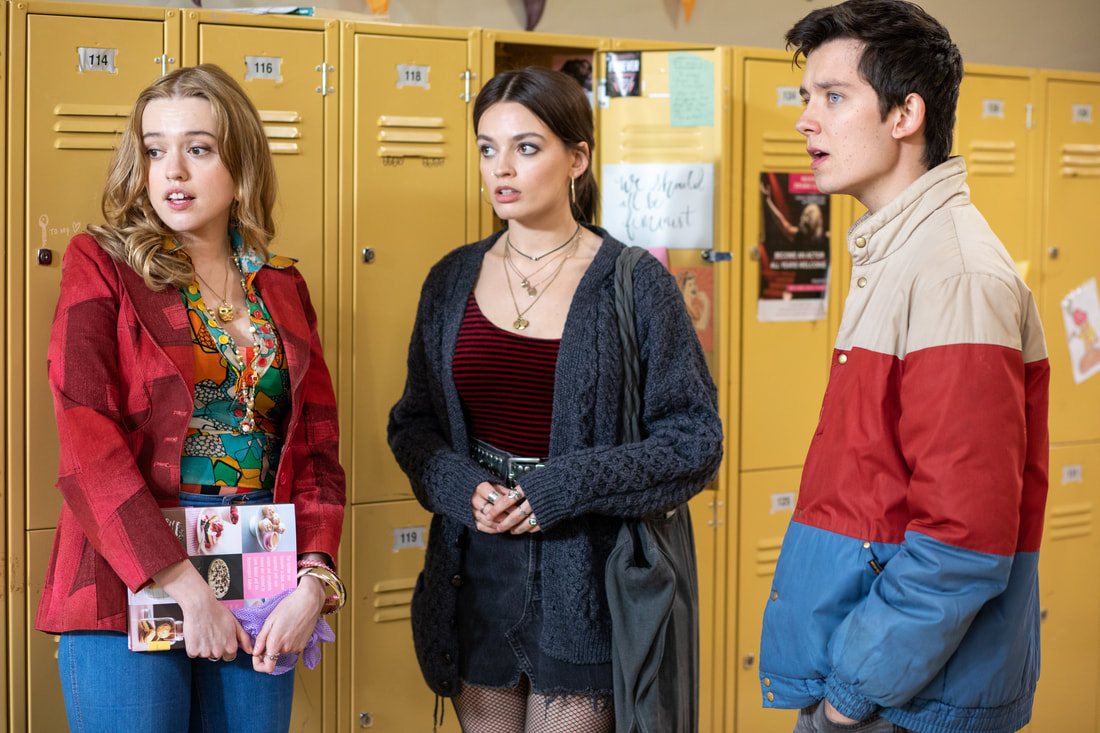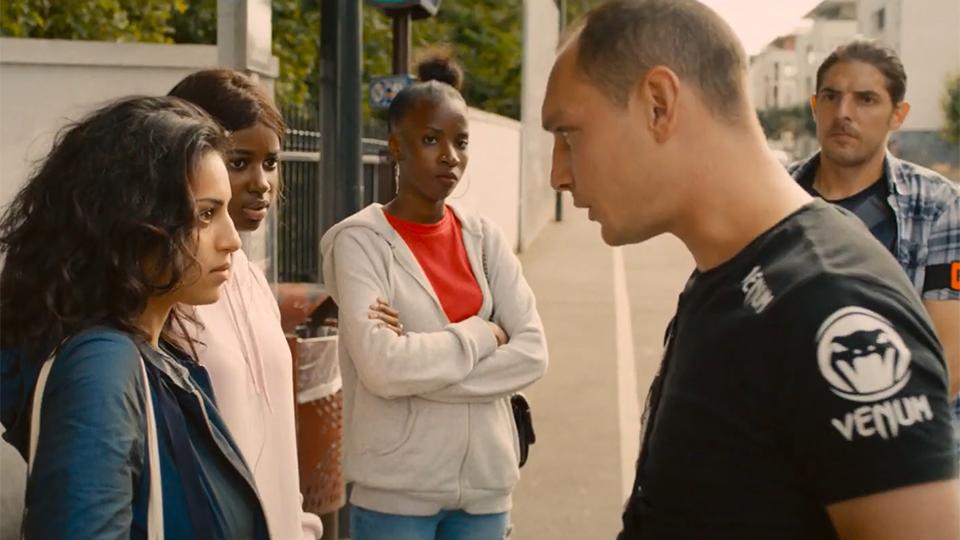|
Review by Camden Ferrell Shoot To Marry is the first documentary in over 15 years from Canadian filmmaker Steve Markle (Camp Hollywood). His newest film is a unique documentary that may have some questionable execution but ultimately proves to be a sweet and heartwarming journey. This movie follows the director, Steve, as he deals with fallout of a nasty breakup. He decides to use his camera and abilities as a filmmaker to interview a number of unique women with the hopes of finding one he can really connect with. It’s an interesting concept, and it feels like the cinematic equivalent of online dating. Unfortunately, despite its unique and engaging premise, the execution is mostly questionable. The film is described as a real-life romantic comedy. However, the documentary really tries to force the rom-com aspects of the film, and it doesn’t translate particularly well. While his self-deprecation is actually quite funny at times, his stream of consciousness as he narrates can be a bit uncomfortable. It’s genuine, but it just feels bizarre and mildly demeaning in context of the film. The film also handles its female interviewees in a less than desirable way. At first, the women are mostly ignored in their interviews, and what they have to say is often overshadowed by the subject’s eagerness to find a romantic connection. It feels like its exploiting the women in a way that could be uncomfortable at times. While this can make sense in context of the subject’s development and arc, it still seems like it’s in poor taste. The women he interviews are genuinely interesting. It’s great how he was able to interview such a wide variety of women from a firefighter to a dominatrix. He will occasionally showcase the talents and hobbies of the women, and this is where the film excels in being a cute story of a man trying to find love. One of the more interesting sections of the movie comes from a hat maker he meets and the fun they have.
The movie also enters into some really bizarre territory. He expands his boundaries as a person, and this leads him to try different things. He goes to a sex club, hires a professional cuddler, and he goes to a workshop on the art of receiving. I admire his willingness to challenge himself as a person, but there are times where his narration and thoughts about these activities (mostly the sex club) can come off as mildly creepy and off-putting. Regardless, it’s these strange moments that give the film a unique voice. Despite its many flaws with its execution, it makes up for a lot of it in its final act. It’s heartwarming and satisfying to see him grow in more ways than one, and it can actually be quite resonant. It’s undeniably sweet, and it is the kind of sweetness that is absent from the first part of the film. He mostly redeems the film’s shortcomings in the way he constructs his emotional and heartwarming journey. Shoot To Marry may sometimes be in poor taste, but it has enough humor and charm to remain engaging. It’s an interesting look into the world of love and dating from a man who is so charmingly awkward at times. While it’s not without flaws, it’ll be interesting to see where Markle goes from here. Shoot To Marry debuted at the 2020 Slamdance Film Festival which runs January 24-30 in Park City, UT. Rating: 3/5
0 Comments
Review by Camden Ferrell Murmur had its premiere at the 2019 Toronto International Film Festival where it won the FIPRESCI Discovery Prize. This docufiction serves as the feature length directorial debut of Heather Young. While the movie can burn a bit too slow at times, its minimalist style and execution effectively tell its emotional story. This movie follows Donna, a woman coming off of a DWI conviction, who participates in community service at an animal shelter. There, she meets and takes home an old dog who is scheduled to be euthanized. As time goes on, we see Donna take in more animals, slowly getting in over her head. This is a premise that works very well due to how simple it is. It’s also a thematically rich story with many layers. Young’s script focuses on a lot of visual storytelling. It doesn’t rely on an abundance of exposition or dialogue to convey the subtext of the protagonist’s actions. Whenever the script uses dialogue, it always feels authentic and natural. It’s very reminiscent of what we experience in our daily lives, and this gives the film a more grounded feeling, and it ultimately succeeds in telling its story. This film is led by newcomer Shan MacDonald. She delivers a powerful and steady performance as Donna. Her performance never feels melodramatic or staged. She succeeds wonderfully in portraying the bleak reality of isolation and addiction all while showing the more humanizing aspects of love and connection. It’s a juggling act that is maintained fairly well from start to finish, and it’s a very impressive debut for MacDonald. The film’s strongest aspect is its cinematography. Jeffery Wheaton brilliantly uses a static camera throughout to capture the realism of each scene. He frames each shot in such a unique way that is oddly beautiful and effective. It’s a strangely alluring hybrid of bleakness and beauty that is extremely sobering.
This film beautifully tells the story of a woman who feels alienated, and the animals that fill a void in her life. Young beautifully captures the innate connection that we feel with animals, and she portrays it in a way that is highly empathetic. It’s undoubtedly adorable, but it also lends itself to moments of solemnity and bittersweet affliction that will resonate with the audience. One of the few downsides of this movie is some of the limitations of its minimalism. It’s a short movie, but there are moments that can really drag on, and it sometimes disrupts a steady and natural flow that the film typically has. Regardless, this movie more than makes up for it with its rich themes and practical execution. Murmur is a deeply human movie that overcomes its pace with a heavy dose of emotion and empathy. It bites off a lot of thematic weight and finds a way to juggle it all within its short runtime. This is a bold and impressive feature film debut for Young, and it suggests a bright and promising future for her. Murmur is screening at the 2020 Slamdance Film Festival which runs January 24-30 in Park City, UT. Rating: 4/5 Review by Sean Boelman Based on an inspiring true story, The Last Full Measure is a new war drama film showing the tremendous impact that a single person can have on the world and the people around them. While the movie does have a tremendously positive message, and a very talented cast, the script is sadly too convoluted for it to be as good as it should have been. The film tells the story of a Pentagon staffer who is assigned to investigate a posthumous Medal of Honor request, sending him on a journey to interview the many people whose lives were changed by the heroism of one American soldier. This movie benefits from being less jingoistic than most Vietnam War dramas, part of the film acting as a criticism of the American government’s poor treatment towards its veterans, though writer-director Todd Robinson can’t seem to find the right balance to make the movie strike its intended chord. Ultimately, the message of the film is that one person can make a huge difference, whether by saving lives or simply listening to a person’s story, and this can lead to a great deal of growth as an individual. However, Robinson does not approach this movie with any element of subtlety, with a well-intentioned but on-the-nose first act and a preachy finale. The result is a film that feels frustratingly artificial. Arguably the biggest issue with Robinson’s movie is that the script is too disorganized. Within the script is a fascinating story, but Robinson’s overbearing use of flashbacks drags down the film’s stronger elements. These portions of the movie, many of which are redundant as they are later explained via expository dialogue, feel like they are trying to force excitement into the film when the testimony of the characters is already interesting enough. Since the movie is centered around an investigation, it follows the protagonist as he interviews different people who knew the honoree. From his fellow battalion members to his parents, the protagonist is exposed to different perspectives as to who Pitsenbarger was, but all of them lead to the same conclusion: that he was a hero. In fact, these assertions are so convincing that seeing him in battle is rather pointless and creates an unnecessarily jarring shift in tone.
These people in Pitsenbarger’s life are played by a phenomenal cast of talented actors, and they do a very good job in their roles. Ed Harris, William Hurt, Christopher Plummer, and Samuel L. Jackson are among the people who have these smaller supporting roles, and they do a very good job of commanding the audience’s attention. That said, the two Washington bureaucrats played by Sebastian Stan and Bradley Whitford have the most meaty scenes, and Stan and Whitford play them quite well. On a technical level, the film is relatively straightforward, shot in a way like any other modestly-budgeted military drama. The war sequences are underwhelming at times, as they feel like an afterthought, a majority of the movie’s budget seemingly having been spent on securing A-list actors for the character-driven portion of the story. There are definitely some very good things happening in The Last Full Measure, but they never come together into a satisfying whole. With some of the flashbacks trimmed out, this film could have been much more lean and effective, but as is, it is a passable drama that will likely offer just enough to satisfy older crowds. The Last Full Measure opens in theaters on January 24. Rating: 3/5 Review by Sean Boelman The directorial debut of filmmaker Kat Alioshin, Animation Outlaws is a new documentary made for anyone who is a fan of animated films. Featuring interviews with numerous recognizable figures within the field of animation, this is an entertaining and creatively-told documentary that effectively pays loving homage to its subjects. The movie tells the story of Spike Decker and Mike Gribble, two friends who came together to start Spike & Mike’s Festival of Animation, a roadshow that honored the best in animated filmmaking before the internet made the medium more widely accessible. Ultimately, Alioshin tells this story in a way that, while narratively straightforward, serves as a compelling underdog story. Over the course of the film, Alioshin traces the life of Decker and Gribble’s tours and explores the impact they had on both the artists whose work was showcased there and the people who were in the audience at the roadshows. Even though this story is very entertaining, there is ultimately too much to be told in such a short period of time. At less than an hour and fifteen minutes long, the movie certainly could have spared to be a bit longer. That said, Alioshin does an excellent job of presenting the subjects in a way that will be intensely sympathetic to the audience. In many ways, the film is at its best when it is an ode to Decker and Gribble. At times, it does start to feel like some of the interviews are leaning a bit too heavily on the nostalgia of the situation, but for the most part, it is a sweet and loving tribute. However, undeniably Alioshin’s greatest success with the movie was in assembling a large group of Festival of Animation alumni to serve as subjects for interviews. Among the interviewees featured in the film are such prominent animators as Pete Docter (Inside Out), Seth Green (Robot Chicken), and Nick Park (Wallace and Gromit). The fact that so many of the interviewees are well-respected lends the movie an even greater sense of legitimacy.
Although the film is admittedly very heavy on talking-head interviews, Alioshin shoots them in a way that is aesthetically pleasing and entertaining. Instead of placing them against a solid background as is standard, Alioshin shows animated shorts behind the person who is talking, and surprisingly enough, this isn’t particularly distracting. The documentary also contains original animated sequences that tell the story of Decker and Gribble as they work to organize and promote their shows. Set to a voiceover by Decker (Gribble unfortunately passed away in 1994), these scenes emphasize the friendship between the two central figures, and as a result, are very heartwarming and fun. With Animation Outlaws, director Kat Alioshin takes a familiar documentary style and turns it on its head, delivering a tribute that is meaningful and entertaining. This is a crowd-pleasing documentary in every sense of the word. Animation Outlaws is screening at the 2020 Slamdance Film Festival which runs January 24-30 in Park City, UT. Rating: 4.5/5 Review by Sean Boelman Inspired by (but not entirely based on) the folk tale of the same name, John Henry is a new crime drama film starring Terry Crews. Because of an enjoyable performance from Crews and a script that is surprisingly thoughtful, this manages to be one of the more ambitious directorial debuts in recent memory. The movie tells the story of a former gang member who is forced to confront his past when a young girl on the run shows up needing his help. Ultimately, the film is rather predictable, particularly if one is familiar with the namesake of the movie, although the way in which co-writers Will Forbes and Doug Skinner transposed this well-known story to the modern day is quite intriguing. What makes Forbes and Skinner’s approach to this story so interesting is that they treat it almost like a superhero story. This makes quite a bit of sense as John Henry is a folk hero — a superhero of the people, whose story is passed down through oral histories and songs — and the result is arguably the most ambitious and satisfying low-fi superhero movie since Kick-Ass. Not everything about Forbes and Skinner’s script is a total home run — there are some significant pacing issues throughout. The first act moves very slowly, and the second and third acts feel entirely rushed. This is particularly the case in the climactic final battle, which occupies far less of the runtime than it likely should. The film also needed some stronger character development. Apart from the eponymous protagonist, the characters in the movie are all relatively flat. Although there are some interesting side characters, such as the protagonist’s comedic relief father, many of the supporting characters feel underdeveloped. Especially troublesome is the lack of development for the damsel-in-distress around whom the film’s plot revolves.
That said, the actors take what they are given with the script and run with it. This role seems like it was written specifically for Crews, as he is an absolutely perfect match for the character. Any action movie that allows Crews to smash some heads in is welcome, but he seems like he is having a particularly fun time with this movie. Ludacris also gives a memorable turn as the antagonist of the film, though Crews frequently steals the scene. On a technical level, the movie is a bit rough around the edges, but that can be expected of a B-movie action flick like this. What is so admirable about this film is its ambition. Forbes, who also serves as director, obviously had a clear vision of what he wanted this movie to be, and it comes across. Stylish and accented by a hip hop soundtrack, this is the sleek starring vehicle that Crews needed at this point in his career. John Henry is certainly quite flawed, but thanks to the talent both in front of and behind the camera, it is surprisingly fun to watch. Though the title may mislead some, this film captures the essence of the folk tale shockingly well. John Henry hits theaters and VOD on January 24. Rating: 3/5 Review by Sean Boelman The long-awaited return to the director’s chair for cult favorite filmmaker Richard Stanley, Color Out of Space, adapted from the short story by H.P. Lovecraft, is a mind-bending new sci-fi horror flick. Thanks to some legitimately disturbing imagery and committed performances all-around, this ends up being one of the scariest movies to come out in a while. The film tells the story of a family whose property is struck by a meteorite, releasing a mysterious aura affecting those who come in contact with it in unusual ways. Like any good Lovecraft tale, the point of this movie is not the story itself, but rather, the eerie atmosphere and the sense of dread it inspires within the viewer. Although this is by no means a traditional horror film, it is arguably scarier than any jump scare would be. Certainly the strongest aspect of this movie are the terrifying visuals inspired by Lovecraft’s writing and gloriously brought to the screen by Stanley. Although this style of horror likely won’t appeal to everyone, those who are a fan of Lovecraftian horror will find that the nightmarish sights of the film hauntingly creep their way under one’s skin. On a technical level, the movie is surprisingly accomplished. While there are a few moments in which the film does show itself as a B-movie, Stanley’s command of the craft often allows the movie to feel a lot bigger than it actually is. Even though the film is set almost entirely on a single property, excellent production design, solid CGI, and wonderful cinematography will immerse the viewer totally into the movie. The only true shortcoming of the film is that it takes a bit too long to get going. Clocking in at around an hour and fifty minutes, this movie is longer than usual for the genre, but for the most part, it earns that runtime. However, in building up to the more disturbing second and third acts, the only mildly creepy beginning delays the audience’s suspense for a bit too long.
Perhaps the most surprising thing about this film is that the character development is quite strong. With the movie being adapted from a short story, there wasn’t a particularly big foundation in terms of characterization from the source material, so Stanley and co-writer Scarlett Amaris are able to make the film their own in this way. Nicolas Cage gives a performance that is admirably bonkers as the patriarch losing control over his family. As one would expect, this movie allows Cage to go all in, and that he does, delivering a turn that is both extremely fun to watch and shockingly nuanced. Other highlights in the cast include Joely Richardson, Julian Hillard, and Tommy Chong, all of whom get their chance to shine. Color Out of Space delivers exactly what sci-fi fans would hope for out of a Lovecraftian horror flick. This film is virtually guaranteed to gain a cult following because even though it does take a while to get moving, it is truly chilling. Color Out of Space plays across the country for one night only on January 22 before opening in theaters on January 24. Rating: 4/5 Review by Sean Boelman Taking a look at the impact of one of the most horrific tragedies in American history, After Parkland is a new documentary exploring the 2018 Marjory Stoneman Douglas High School shooting. However, despite the wealth of personal stories from which the filmmakers drew, the film underwhelms due to an overbearing attempt to make a political statement. The movie tells the story of the victims of the shooting, with a focus on the survivors and how they overcome the grief and trauma from what they have experienced. There is a lot of story here, and directors Jake Lefferman and Emily Taguchi (both of whom come from a background in ABC News) try their best to juggle it all, but unfortunately, they are unable to do so in a way that feels balanced and fully developed. Out of the hundreds of victims, Lefferman and Taguchi chose a handful to follow over the course of the film, mostly because of their political activism. However, with some of these selections comes the idea that the movie is rehearsed and distanced from the truth. The most authentic and effective moments in the film come not from interviews with the more politically active survivors, but rather, those who are simply trying to make it through life with the weight of their grief hanging over their head. It becomes obvious very early on that Lefferman and Taguchi are using this movie to make a statement about gun control, and while there is merit to their argument, the way in which they go about supporting it on screen is largely unsuccessful. In one interview, the subject even discusses how Lefferman and Taguchi are pushing him to talk about something other than what he had intended. On an emotional level, one would think that this film would be immediately resonant because of how heart-breaking the tragedy at its core is, but it isn’t always the home run that one would expect. After a while, the movie’s repeated attempts at tear-jerking start to feel monotonous and end up losing much of their effect. The more affecting moments come when the film is trying to be uplifting, showing how these victims are overcoming the odds to beat their grief.
Clocking in at just over an hour and a half long, the movie simply doesn’t have enough time to explore all of the moving parts of the story with sufficient depth. Lefferman and Taguchi’s approach to the story likely would have lent itself more readily to an extended television special or a miniseries rather than a theatrical documentary like this. Visually, Lefferman and Taguchi’s documentary is somewhat lackluster, but that can almost be forgiven because of the run-and-gun-like nature of the film. This movie picks up with the victims very soon after the shooting, and as a result, there wasn’t much time for planning. Lefferman and Taguchi do the best they can with the footage they have, but in more cinematic hands, this story could have been far more captivating. After Parkland is worth watching if only to hear the stories of its subjects, but there will likely be another film down the line that handles this topic more effectively. Still, this movie does have enough going for it that it could be the conversation starter that is needed for these discussions. After Parkland will be screening nationwide for one night only on February 12. Reserve tickets by February 3 at bit.ly/afterparkland. The film will then stream on Hulu beginning February 19. Rating: 2.5/5 Review by Sean Boelman After the first season unexpectedly won over the hearts of both audiences and critics, the second season of Netflix’s coming-of-age comedy series Sex Education returns with the promise of more secondhand embarrassment. Featuring the same level of humor and doubling down on the heart, this new season feels like the perfect continuation of this story. This season follows Otis as he continues to give sex advice to his classmates all the while learning from himself through his new relationship and his lingering feelings for his former business partner Maeve. Perhaps the most impressive thing about this series is its ability to juggle all of the different moving parts effectively. Even more so than last season, these new episodes feature a ton of variety in the storylines, and yet none of them feel pointless or underdeveloped. Arguably the greatest improvement between the first and second season is the fact that the second batch features a much more diverse group of characters. Although the first season did involve a storyline involving a main character coming to terms with his sexual identity, the series as a whole felt somewhat heteronormative in regards to its treatment of relationships. This season does a lot more to explore other relationships and identities, from a deeper look at a same-sex relationship to the introduction of an ace character. The film also approaches some much more hard-hitting themes outside of the coming-of-age storyline. One of the most effective subplots of the film explores sexual assault and the impact and consequences it has on its victims. This is much darker than anything the series had tried to tackle before, and it works, giving this season an even greater sense of urgency and timeliness. It will be interesting to see how this show continues to move forward with these ideas. Of course, as one would expect, the series keeps up with its ridiculous and raunchy sense of humor that made the first season so widely beloved. Only this time, the comedy is complemented by an even greater level of substance. The writers of this series have figured out how to make a hilarious scene out of a situation that is uncomfortable but can often be considered taboo. Although one would expect that this premise can only go so far, the series’ writers haven’t seemed to have run out of riotous jokes yet.
Just as before, the cast of the film is extremely charming. Asa Butterfield, who first gained notice as a lead of young adult literature adaptations, seems more fit for this type of comedic work. He absolutely nails the delivery of the lines, and he is endlessly charming as the quirky and goofy kid. His chemistry with co-star Emma Mackey, who is great herself, is also excellent. The supporting cast of the film is great too. Gillian Anderson of The X-Files fame is hilarious in her expanded role in this season. Whereas in the first season, she served as little more than an incitement for the comedic tendencies of the protagonist, she gets her own compelling storyline in this film, allowing Anderson to show the full range of her chops. Another standout in the supporting cast is Connor Swindells, who brings even more subtlety and nuance to his character this time around. Season two of Sex Education is somehow an improvement on the already excellent first batch, featuring even more laughs and a great deal of heart. Although it is unlikely that there could be any more improvement, it will be exciting to see where the creators take these characters next. Sex Education is now streaming on Netflix. All eight episodes reviewed. Rating: 5/5 Review by Sean Boelman Not to be confused with the Victor Hugo novel or its musical adaptation, Ladj Ly’s new film Les Misérables is united with its namesake in the fact that they are both searing explorations of the French justice system. Expanded from Ly’s short of the same name, this is an ambitious, if at times messy, feature debut from a filmmaker with a very defined and passionate voice. The movie follows a young cop on his first day on the job in an impoverished suburb in France as he comes to terms with the conflicts between the police and the various underworld criminal organizations that lay claim to the streets. Ultimately, the plot is simple, little more than a device to deliver the social commentary that Ly has on his mind. However, the things that Ly has to say are very compelling, and as a result, the film is truly fascinating. If Ly should be faulted for anything, it is that he tries to juggle too much with his narrative. Ly’s perspective is undeniably refreshing and unique, but with the movie’s runtime clocking in at under an hour and forty five minutes, some of the film’s themes aren’t explored with the depth for which Ly obviously shows the potential. The movie’s discussion of police brutality is very important and quite resonant, but it often feels like the exploration of racism could have been even more hard-hitting than it was. One of the most intriguing things about Ly’s style is the way in which he handles such gritty and grounded topics with a story that is somewhat fanciful at times. A significant portion of this film’s plot revolves around the main characters as they investigate the disappearance of a gang leader’s prized baby lion. With this bizarre and almost humorous twist on a familiar tale, Ly takes what could have been straightforward didactics and turns it into something more satirical and perhaps even more effective. Ly also does a very good job of presenting the characters of the movie in a morally ambiguous light. While the film does take a very clear stance on the topic of police brutality, it does not simply villainize the characters. Instead, Ly takes a much more nuanced approach, making the audience understand the nature of these characters not through over-the-top dialogue or a manipulative shooting style, but the realism of the atrocities which they commit.
The two lead actors of the movie do an absolutely wonderful job in their roles, providing a great dramatic foil for each other. The relationship between the two leads, a veteran and the new kid on the block, is developed organically through the chemistry of the two actors that play them, Damien Bonnard and Alexis Manenti. Bonnard is particularly impressive as the idyllic transfer, his expression of emotion throughout the film closely mirroring what the audience is feeling. Visually, Ly shoots the movie in a gritty and down-to-earth way, seemingly in the hopes that the film will pack even more of an emotional punch. While this does backfire at times, making the movie feel overly messy, the purposefully unpolished nature of the film does a respectable job of transporting the audience into the streets of France. By shooting the movie from a perspective not too dissimilar from that of the protagonist, Ly cements the audience as seeing the film from the perspective of an outsider newly entering this situation themselves. Les Misérables is admittedly a bit rough around the edges, but as a showcase for Ly’s talents and potentials, it is a fine feature debut. Ly is certainly someone to watch, as he obviously has quite a bit to say, and he has the skill set to do it. Les Misérables is now playing in theaters. Rating: 4.5/5 Jezebel premiered at the 2019 SXSW Film Festival, and it serves as the feature directorial debut of Numa Perrier. This is a low-budget film that was partially funded through GoFundMe. While this film is clearly a personal story for the director, it sometimes lacks the narrative drive to remain consistently engaging. This movie takes place in the 90’s and follows Tiffany who, with the help of her sister, gets a job as a cam girl to make ends meet after the death of their mother. This is a semi-autobiographical film that Perrier both wrote and directed. It’s an interesting concept due to the nature of sex work and how it operated in the 90’s. Overall, the writing is fairly decent. It has some nuances that heighten the realism of each scene, but there are also moments that feel a bit contrived. The dialogue isn’t super well-written, and it only gives a superficial understanding to its characters. However, through her direction of the actors, Perrier is able to communicate her intent and characterization better. The best aspect of this film comes from the lead performance. Tiffany Tenille makes her feature film debut in this movie. She is able to give a tangible spirit to her character as we join her on her journey into the industry. It’s interesting to watch her try and become accustomed to her job. Through every interaction in her line of work, we learn more about her and see her grow as a character. It’s not perfect, but Tenille shows a lot of promise through her performance in this movie. The movie also introduces a side plot about a frequent customer with whom she grows an attachment. It’s a bizarrely sweet relationship in a world that is often defined by the sexual shamelessness of its clientele. However, this is a story that I would have liked to see more of in the movie, but with a limited budget and condensed runtime, I can understand why it had to be short.
On a technical level, it’s a fairly impressive indie film. The cinematography is subtle when it needs to be, but it also knows when to be erratic and vivacious. It really helps show the mental state of working in this industry and adds further depth to the struggles of its protagonist. There are some really effective moments that are created due to the cinematography, editing, and execution. Unfortunately, this movie can spend a lot of its time meandering on plot points that don’t really warrant the attention. It seems that the movie bites off a lot more than it can chew. The movie tackles a lot of heavy subjects that just aren’t addressed in an efficient manner, and it really bogs down an interesting premise. It’s a rather short film that feels somewhat extended by some of its narrative shortcomings. Jezebel is an interesting look into the life of a cam girl, and it’s a personal story, but it isn’t as engaging as one would hope. It shows a lot of promise for its director and its star, and it is an admirable feat of indie filmmaking. Jezebel is currently streaming on Netflix. Rating: 3/5 |
Archives
July 2024
Authors
All
|
|
|
disappointment media
Dedicated to unique and diverse perspectives on cinema! |





